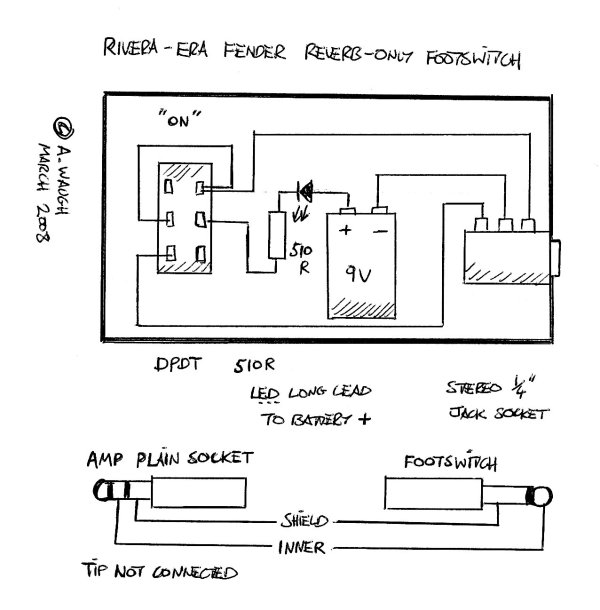
NB
This footswitch is intended to work with the Rivera-era Fender amps
from 1982-86.
It probably won't work with any other amps.
It fixes a problem which (I think) only exists for some PRIIs and some
Super Champs.
I have built
one for my PRII and I'm very pleased with the result - full clean tone
and
switchable reverb, all I've wanted since I got the amp 6 years
earlier...

To complete this footswitch you need to
wire up a cable as shown at the bottom of the above diagram. It could
be made out of an ordinary guitar cable, replacing one end with a
stereo jack plug as shown. Note the stereo jack plug tip is not
connected. The stereo end goes to the amp plain footswitch socket, and
the mono end goes to the footswitch.
PRACTICAL
BUILD
When planning to make mine, I looked for a suitable box - it needed to
be strong, with a 9V battery compartment. I suddenly realised I already
had one on my desk - a faulty DI box! It was made in China by a company
with a German-sounding name. It hadn't been very reliable but the
aluminium extruded box and the four huge rubber corners looked great.
All I had to do do was drill a hole in the top for the switch and
another for the LED. There was already a hole for the jack socket and a
9V battery compartment with a handy little door held shut with a
thumbscrew. Drilling and wiring took only an hour! (That same company
made my band's PA mixer and it's great, by the way...)
If you have an old, faulty effects pedal, that might also give you the box you need.
TEST
BEFORE USE
Fit a battery. Insert the cable mono jack into the footswitch's socket.
Don't connect to the amp. Work the switch and check the LED switches on
and off. Use a multimeter or continuity tester on the other end of the
cable (stereo plug) to check
The above advice is offered in good faith but I accept no responsibility for loss, damage, injury, death, blown up amps, etc etc. I'd appreciate it if you'd treat my write-up and sketches as copyright 2008 Andrew Waugh. Thanks.